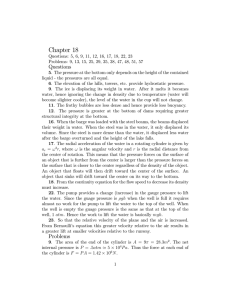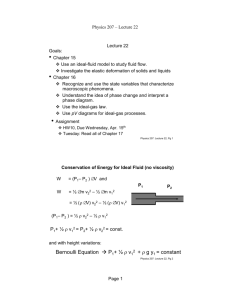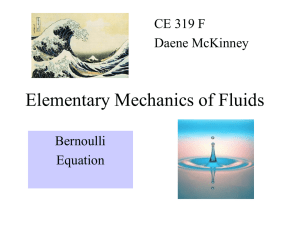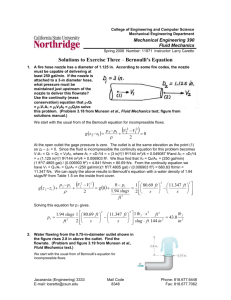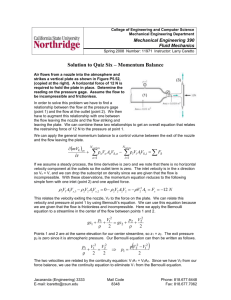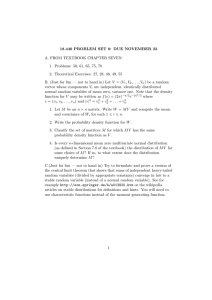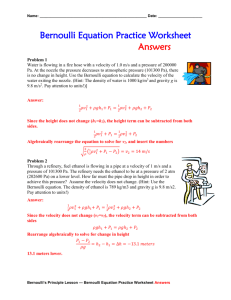Lecture 5 • Contents
advertisement
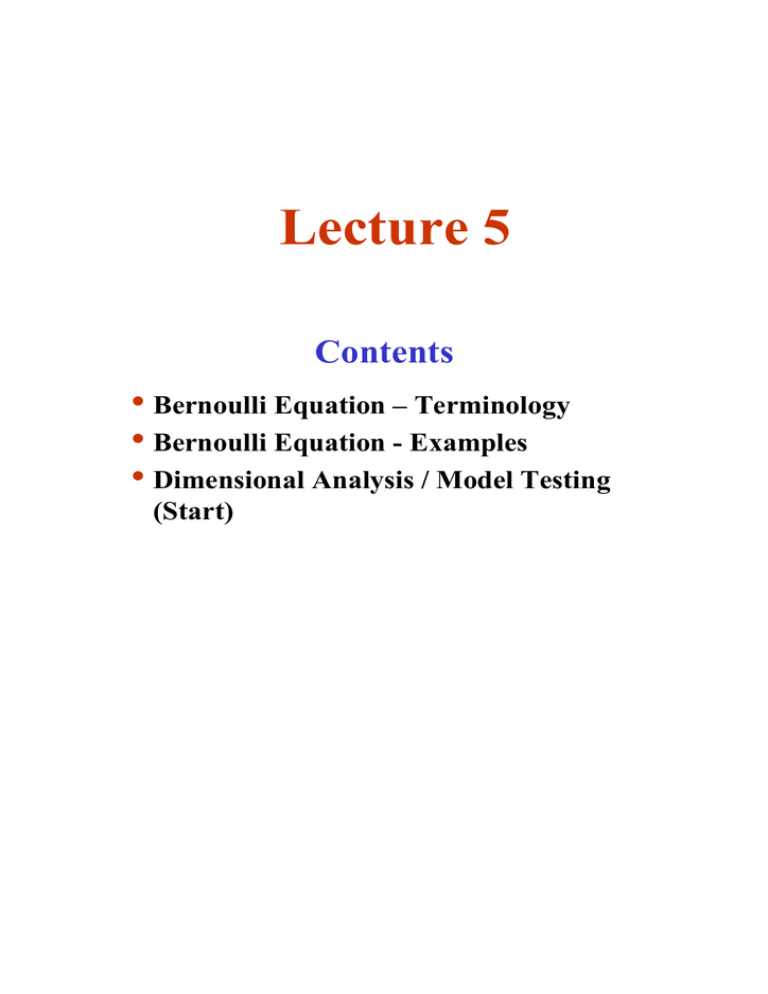
Lecture 5 Contents • Bernoulli Equation – Terminology • Bernoulli Equation - Examples • Dimensional Analysis / Model Testing (Start) EXAMPLE CLASSES Bring along any questions you may have … What Did We Do In Last Lecture? Derivation of Bernoulli Equation p + ρ 2 v 2 + ρ g z = const. • Constant along streamline • All terms have units of pressure • p is the physically existing pressure • 2nd term is kinetic energy per unit volume associated with mean motion of flow • 3rd term hydrostatic pressure What Did We Do In Last Lecture? Keep in mind analogy … Epot + Ekin = const. Finished previous lecture with … BERNOULLI EQUATION p v2 + + z = const. = H ρ g 2g Alternative Form p+ ρ 2 v 2 + ρ g z = const. (7) • Equations apply along a single stream line. • Constant for each streamline can be different. Continued... • Eq. (7) from previous lecture / slide … p+ ρ 2 v 2 + ρ g z = const. (7) • If Eq. (7) applied along streamline between any two points indicated by suffixes 1 and 2 one gets ... p1 + ρ 2 v12 + ρ g z1 = p2 + ρ 2 v22 + ρ g z2 This is form in which we will usually apply Bernoulli Equation most of the time. Continued... • Note: For compressible fluid integration of Euler’s equation ... 1 dp dv dz +v + g =0 ρ ds ds ds can only be partially completed to give ... dp v 2 ∫ ρg + 2 g + z = 0 Now need relation between density and pressure to continue. Terminology for Bernoulli Equation p (1) + ρ 2 v2 (2) + ρgz = (3) const. (4) (STATIC) PRESSURE (1) = The physically existing pressure in fluid. Whenever reference is made to “pressure” without further qualification then interpret as this one. DYNAMIC PRESSURE (2) = Not a physically existing pressure. If z=0, such that Elev. Press. Vanishes, then Dyn. Press. is the difference between Tot. Press. And Stat. Press. ELEVATION PRESSURE (3) = Can often be made to vanish, i.e. when streamline horizontal such that we can chose z=0. If streamline not horizontal, but if change in height is small such that Elev. Press. is small compared to other terms one usually neglects it. TOTAL PRESSURE (4) = This has physical significance that it is the pressure at which fluid comes to rest. Assume z=0, V=0 then one gets: Stat. Press=Tot. Press. Terminology for Bernoulli Equation + p • ρ 2 v2 + ρgz = const. Note that the STATIC PRESSURE is NOT the pressure in a static fluid (that is called the hydrostatic pressure). • Neither is the STATIC PRESSURE the pressure where the fluid is at rest (that is called the stagnation pressure). Terminology for Bernoulli Equation • For ... p1 + ρ 2 v12 + ρ g z1 = p2 + v2 = 0 and With: p1 + • ρ 2 ρ 2 v22 + ρ g z 2 z1 = z 2 v12 = p2 Hence sum of static pressure at station 1 plus dynamic pressure at station 1 is equal to static pressure at station 2 where fluid is at rest (stagnates). Thus we call ... p1 + ρ 2 v12 = Stagnation Pressure (or Pitot Pressure) Final Terminology • When Bernoulli written in form ... p ρg (1) + v2 2g (2) + z = const. (3) (4) … such that all terms in units of ‘LENGTH’ then one calls ... (1) = STATIC HEAD (2) = DYNAMIC HEAD (3) = ELEVATION HEAD (4) = TOTAL HEAD … and finally ... (1) + (2) = STAGNATION HEAD And recall that ... Pressure measured relative to atmospheric pressure is called ... GAUGE PRESSURE or GAGE PRESSURE … as distinct from ABSOLUTE PRESSURE Example 1: Pitot-Static Tube / Prandtl Tube Continued … (1) (2) p1 p2 v1 = ? v2 = 0 Question: What is value of v1? Solution: • Bernoulli for points (1) and (2) p1 + • ρ 2 v12 + ρ g z1 = p2 + ρ 2 v22 + ρ g z2 Neglect hydrostatic pressure; horizontal streamline … p1 + ρ 2 v12 + ρ g z1 = p2 + p1 + ρ 2 v12 = p2 + ρ 2 ρ 2 v22 + ρ g z2 v22 Continued … • (1) (2) p1 p2 v1 = ? v2 = 0 Point (2) is stagnation point where velocity is zero … p1 + ρ 2 v12 = p2 + p1 + • ρ 2 ρ 2 v22 v12 = p2 Solve for velocity … v1 = 2 ρ ( p2 − p1 ) Continued … (1) (2) p1 p2 v1 = ? v2 = 0 Stagnation Pressure • Free-Stream Static Pressure. Solve for velocity … v1 = 2 ρ ( p2 − p1 ) [Pressure here Equal to p1 at point (1) since it is assumed that probe does not affect flow.] Continued … Pitot-Static Tube / Prandtl Tube • This type of probe/methodology is used in my Vortex / • Wind tunnel Lab L5 to measure free stream velocity via pressures! In lab I will assume that you are familiar with this! • In lab will work with arrangement similar to that shown below. The difference being that aeroplane is replaced by a circular cylinder, and probe not in wake of cylinder but in region where flow is not affected by presence of cylinder. Pitot-Static / Prandtl Tube Example 2: • Water flowing in open channel at depth of 2m and velocity 3m/s. It then flows downs contracting chute into another channel where depth is 1m and velocity 10m/s. Assuming frictionless flow, determine difference in elevation of the channels. (1) 2m 3m/s y=? ( 2) 1m 10m/s Solution: • Bernoulli for points (1) and (2) p1 + • ρ 2 v12 + ρ g z1 = p2 + ρ 2 v22 + ρ g z2 (A) Since (1) and (2) on free surface: p1 = p2 = patm. Eq. (A) becomes... ρ 2 v12 + ρ g z1 = ρ 2 v22 + ρ g z2 (B) Continued ... (1) 2m 3m/s y=? 1m • 2 v12 + ρ g z1 = ρ 2 v22 + ρ g z2 • From sketch we see... z1 = y + 2 m • Introduce this into (B) ... ρ 2 v12 + ρ g ( y + 2 ) = ρ 2 (B) v22 + ρ g z2 (C) Solve (C) for y ... y= • 10m/s Last line from previous page repeated... ρ • ( 2) ( ) 1 2 2 v2 − v1 + ( z2 − 2 m ) 2g (D) With given values ... v1 = 3 m/s , v2 = 10 m/s , z2 = 1 m Continued... • Eq. (D) yields... y= 2 2 ( ) [ ] [ ] 10 m/s − 3 m/s + (1 m − 2 m ) 2 2 ⋅ 9.81 m/s 1 = 3.64 m Example 3: VENTURI TUBE Example 3: VENTURI TUBE • Venturi tube is device where flow rate in a pipe line is measured by narrowing a part of tube. In narrowed part flow velocity increases. By measuring resultant decreasing pressure flow rate in pipe line can be determined. ρ m (with ρ < ρ ) m w (3) D2 with Area, A2 ( 2) ρw Water z2 z1 (1) D1 with Area, A1 z=0 Solution: • Bernoulli for points (1) and (2) ρ ρ p1 + w V12 + ρ w g z1 = p2 + w V22 + ρ w g z2 (1) 2 2 • Mass conservation yields... A1 V1 = A2 V2 A V2 = 1 V1 A2 (2) Continued ... • Substituting Eq. (2) into Eq. (1) gives... ρw ρ w ⎛ A1 2 ⎞ ⎜⎜ V1 ⎟⎟ + ρ w g z2 p1 + v12 + ρ w g z1 = p2 + 2 2 ⎝ A2 ⎠ • Rearrange ... ⎛ ⎛ A ⎞2 ⎞ V12 ⎜ ⎜⎜ 1 ⎟⎟ − 1⎟ = ( p1 − p2 ) + ρ w g ( z1 − z2 ) ⎟ ⎜ ⎝ A2 ⎠ 2 ⎝ ⎠ ρw V1 = ( p1 − p2 ) + ρ w g ( z1 − z2 ) ρ w ⎛⎜ ⎛ A1 ⎞ ⎞ ⎜⎜ ⎟⎟ − 1⎟ ⎟ 2 ⎜ ⎝ A2 ⎠ ⎝ ⎠ 2 = This solution is maximum velocity V1 which would exist for frictionless flow. In reality there is viscosity present and one introduces a discharge coefficient cd such that ... (V1 )actual = cd (V1 )ideal • To apply above equation still need to evaluate pressure difference ... Continued ... • How to get pressure difference …. ∆h ρm h l Water, ρ w z2 − z1 ( 2) (1) • Use pressure-depth ideas developed earlier. Summing up all pressure contributions on path from (1) to (2) ... p1 − ρ w g ( z2 − z1 ) − ρ w gl − ρ w gh − ρ m g∆h + ρ m g∆h + ρ m gh + ρ w gl = p2 p1 − p2 = ρ w g ( z2 − z1 ) + ρ w gh − ρ m gh p1 − p2 = ρ w g ( z 2 − z1 ) + ( ρ w − ρ m )gh Example 4: Beavers with engineering degrees discovered use of Bernoulli principle to ventilate burrows ! Example 4: • Beavers with engineering degrees discovered use of Bernoulli principle to ventilate burrows. If burrow as below than at one entrance wind velocity increases, creating a pressure differential that induces air flow through burrow. Calculate the pressure difference between entrance and exit for the friendly beaver... V = 22 km/h Streamline ( 2) V = 18 km/h (1) p 2 < p1 ρ air = 1.225 kg/m3 Solution: • Bernoulli for points (1) and (2) p1 + • ρ 2 v12 + ρ g z1 = p2 + ρ 2 v22 + ρ g z2 (A) Assume negligible elevation change, hence: z1 = z2 p1 + • ρ 2 Eq. (A) becomes... v12 = p2 + ρ 2 v22 Solve (B) for pressure difference ... (B) Continued... • Last equation from previous slide repeated... p1 + ρ 2 ρ v1 = p2 + v22 2 2 ∆p = p1 − p2 = • (C) With given values... v1 = 18 km/h = 5 m/s • ( v22 − v12 ) 2 ρ v2 = 22 km/h = 6.11 m/s Eq. (C) yields ... ( 1.225 kg/m3 [6.11 m/s]2 − [5 m/s]2 ∆p = p1 − p2 = 2 ) kg m 2 N s = 7.55 = 7.55 = 7.55 = 7.55 Pa 2 2 2 ms m m kg • p1 = p2 + 7.55 Pa pressure at exit (1) is So, since higher than pressure at exit (2). This pressure difference drives a venting flow from (1) towards (2). Example 5: Homework/ Background Reading • A hurricane is a tropical storm formed over ocean by low atmospheric pressures. As hurricane approaches land, inordinate ocean swells (very high tides) accompany hurricane. A Class-5 hurricane features winds in excess of 240 km/h, although wind velocity at center “eye” is very low. In sketch below atmospheric pressure 310 km from eye is 101,591 Pa (558.8 mm Hg at point 1, generally normal for ocean) and winds are calm. Hurricane atmospheric pressure at eye at point (3) is 74,500 Pa (762 mm Hg). (I) Estimate ocean swell at eye of the hurricane at (3) (II)Estimate ocean swell at (2) where wind velocity is 310 km/h. Eye Hurricane Calm Ocean (1) Level ( 2) h2 (3) h1 Ocean Continued ... Assumptions • Steady, incompressible, irrotational (so that Bernoulli applicable) (Note: This is certainly a very questionable assumption for a highly turbulent flow) • The effect of water drifted into air is negligible Properties Density air ρ A = 1.225 kg/m Density sea water 3 ρ SW = 1023 kg/m 3 Density Mercury ρ M = 13,560 kg/m 3 Continued, Cengel p. 199 ... Solution, Part (I): • Reduced atmospheric pressure over the water causes to rise. Thus decreased pressure at (3) relative to (1) causes ocean water to rise at (3). Hence... ∆p = ( ρgh )Hg = ( ρgh )SW ρ Hg ghHg = ρ SW ghSW hSW = hSW = 13,560 kg/m 3 1023 kg/m 3 ρ Hg hHg ρ SW (A) (762 mm Hg − 558.8 mm Hg ) = 2.693 m • This result is equivalent to the storm surge at the eye of the hurricane since the velocity there is negligible and there are no dynamic effects. Continued... Solution Part (II): • Here we have to take the high wind speed into account and need Bernoulli. We write down Bernoulli equation for points A and B... p A v A2 p B vB2 + + zA = + + zB ρg 2 g ρg 2 g • Since zA=zB and vB=0 we have... p A v A2 p + = B ρg 2 g ρg 2 ⎛ 240,000 m/s ⎞ ⎜ ⎟ pB − p A v A2 ⎝ 3600 ⎠ = 226.5 m = = 2g ρg 2 ⋅ 9.81 ms-2 • Density value to be used is air density in hurricane... ρ Hur = PAir Patm, Air ρ atm, Air = 74,500 Pa ⋅1.225 kgm 3 101,591 Pa = 0.898 kgm 3 Continued... • Using relation (A) from Part (I) we get ... hdynamic = hSW = ρ Air hAir ρ SW 0.898 kg/m 3 1023 kg/m 3 ⋅ 226.5 m = 0 .2 m • Therefore pressure at (2) is 0.2m seawater column lower than pressure at point (3) due to high wind velocities, causing ocean to rise an additional 0.2 m. Then total storm surge at point (2) becomes... h2 = h1 + h dynamic = 2.693 m + 0.2 m = 2.893 m DISCUSSION Problem involves highly turbulent flow and intense breakdown of streamlines. Thus, applicability of Bernoulli equation in Part (II) is questionable. Furthermore, flow in eye of storm is not irrotational, and Bernoulli constant changes across streamlines. Bernoulli analysis can be thought of as limiting, ideal case, and shows that rise of seawater due to highvelocity winds cannot be more than 2.893m. Dimensional Analaysis and Model Testing •Introduction to Dimensional Analysis Consider drag D of sphere …. On what quantities does it depend? Diameter, d Flow Speed, V Fluid Density, ρ Fluid Viscosity, µ Write D = F (d ,V , ρ , µ ) (1) • Note: Eq.(1) reads … Drag, D, is a Function of ... What does the above mean in terms of the measurements we have to carry out to collect data for all possible spheres in all types of fluids? Continued ... WE NEED ... 1 page for Drag as function of 2 variables (e.g. velocity and diameter) d increases from curve to curve 1 page for each value of ρ 1 book for Drag as function of 3 variables (e.g. velocity, diameter, density) Shelf of books for Drag as a function of 4 variables (velocity, diameter, density, viscosity) If we want 10 data points per curve, at £10 each experiment, this will cost... 10 × 10 × 10 × 10 × £10 = £100,000 THERE MUST BE A BETTER WAY !?!? Continued... DRAG GOAL IS TO COMPRESS SHELF OF BOOKS INTO ONE SINGLE GRAPH... 4 Independent Experimental Parameters How Could We Possibly Achieve This?
